Creating and Managing Virtual Summary Tasks for Version 7.0
Contents
- 1 About Creating and Managing Virtual Summary Tasks
- 2 Creating and Undoing Virtual Summary Tasks
- 3 Setting Percent Complete for Virtual Summary Tasks
- 4 Critical Path Segments in Virtual Summary Tasks
- 5 Displaying Milestone Symbols on Virtual Summary Tasks
- 6 Task Links and Virtual Summary Tasks (VST)
- 7 Related Links
About Creating and Managing Virtual Summary Tasks
A virtual summary task (VST) is a summary task bar created by OnePager that does not exist in Microsoft Project or Excel. It represents the start date and end date of two or more constituent task bars or milestone symbols. In this respect the VST is a OnePager summary task displayed in the chart. OnePager computes the start and end dates of a VST as its constituent task dates change from snapshot to snapshot. It also constructs baselines, percent complete bars, and critical path segments (One Pager Pro (OPP) only) for task bars being summarized. The illustrations and examples in this article are from OnePager Pro.
Creating and Undoing Virtual Summary Tasks
Make a Virtual Summary Task
To create a Virtual Summary Task (VST), follow these steps.
- 1) Select the first task bar or milestone symbol.
- 2) Use the CTL+Left-Click method to select the second (and third, fourth, etc.) constituent task bars and milestone symbols. Or use the Lasso method to select the desired task bars or milestone symbols.
- 3) Right-click on any of the selected task/milestone symbols to access the task bar right-click context menu shown below.
- 4) Click the Make into virtual summary task command as shown below:
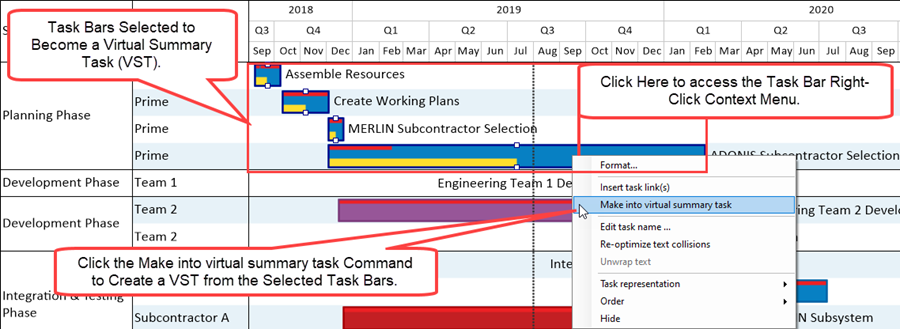
The chart now looks like this:

If there are Task Links associated with the selected task bars their Task Links are not shown in the resulting VST.
Unmake a Virtual Summary Task
To unmake the VST, right-click on the VST to access the task bar right-click context menu, and click the Unmake virtual summary task command in the context menu.
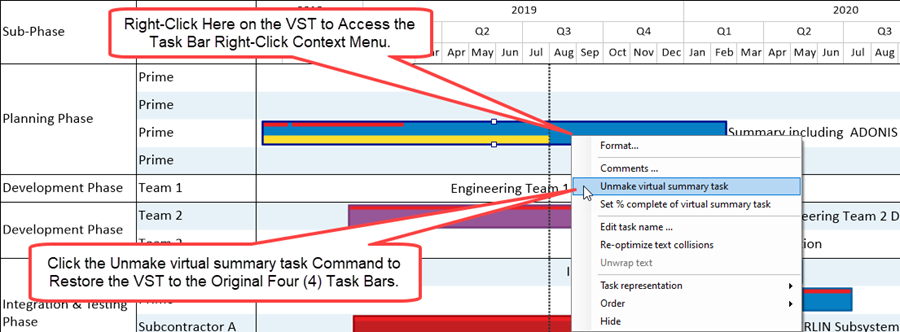
When a VST is unmade, any Task Links associated with the participating selected task bars are restored.
Setting Percent Complete for Virtual Summary Tasks
Because a VST is really a collection of several other task bars, it is not always clear how to define its percent complete value. By default, the percent complete for a VST is computed by OnePager so that the progress bar touches the time now line even if the Time Cursor is displayed or not in the chart as shown below:

This value cannot always be appropriate because of the positions of the selected task bars with respect to the time now vertical line (usually the snapshot date). In some cases there won’t be a percent complete calculated or in other cases the percent complete can be illogical. You can override this default and set the percent complete value manually by using these steps. Right-click the VST to access the task bar right-click context menu and then click the Set % complete of virtual summary task command shown below:
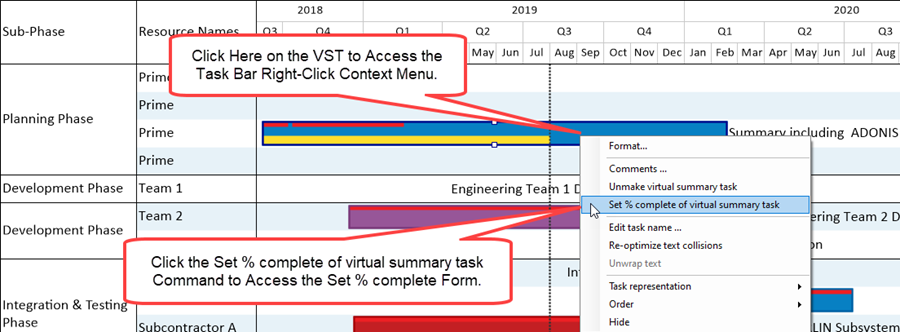
Enter the new percent complete value and click OK.

After clicking the OK button, the VST and its percent complete bar look like this:

Critical Path Segments in Virtual Summary Tasks
OnePager Pro consolidates critical path segments into the VST from the constituent individual task bars and milestone symbols. This feature is not available in OnePager Express (OPX) because OPX does not process critical path information. In the OnePager Pro chart below, there are four (4) task bars that are selected to become part of a VST:
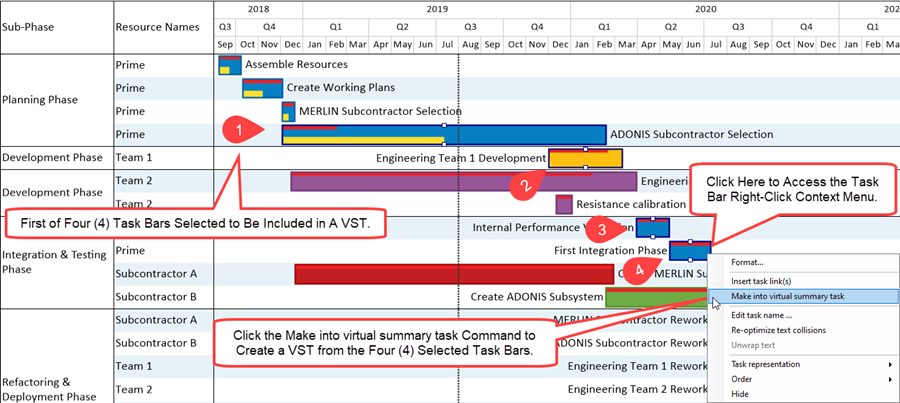
When the VST is created, the VST itself looks like this with consolidated critical path segments.
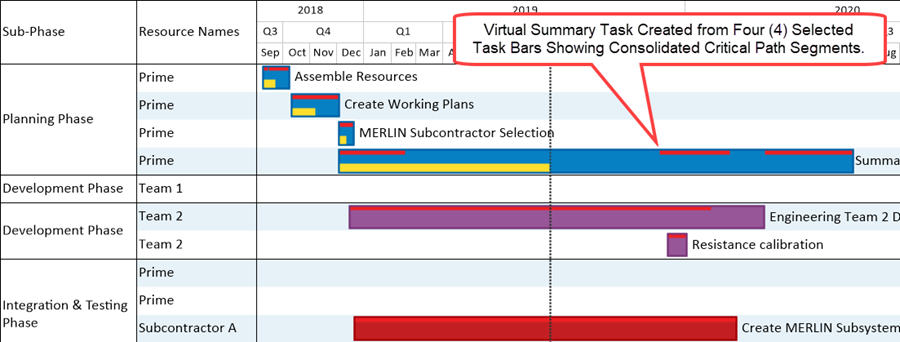
Displaying Milestone Symbols on Virtual Summary Tasks
Many users often represent their charts entirely with milestone symbols normally to focus attention to start dates and finish dates as shown here with milestone symbols represented at finish dates:
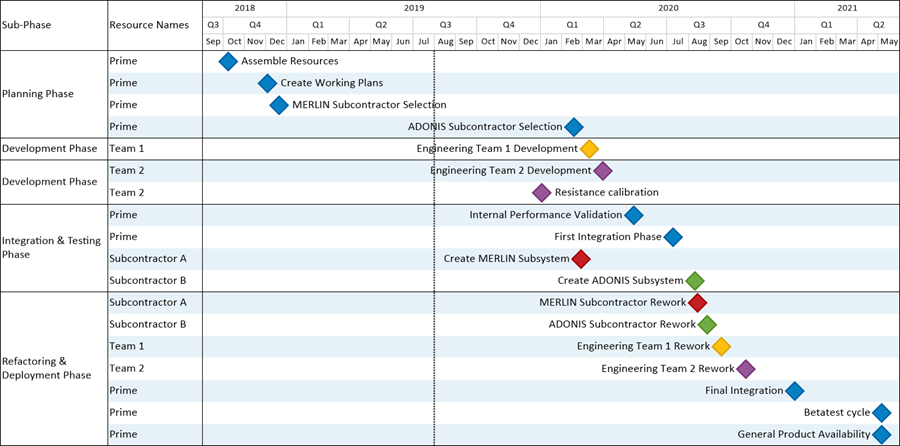
OnePager can represent any VST configured under circumstances where a VST is created from milestone symbols only, displays the VST bar with the collected milestone symbol shown on top of the bar as illustrated below:

To control the use of this feature, a checkbox was added to the Chart Properties form’s Advanced tab’s, Display options control group called Overlay VST element to turn this feature ON and OFF as shown below:
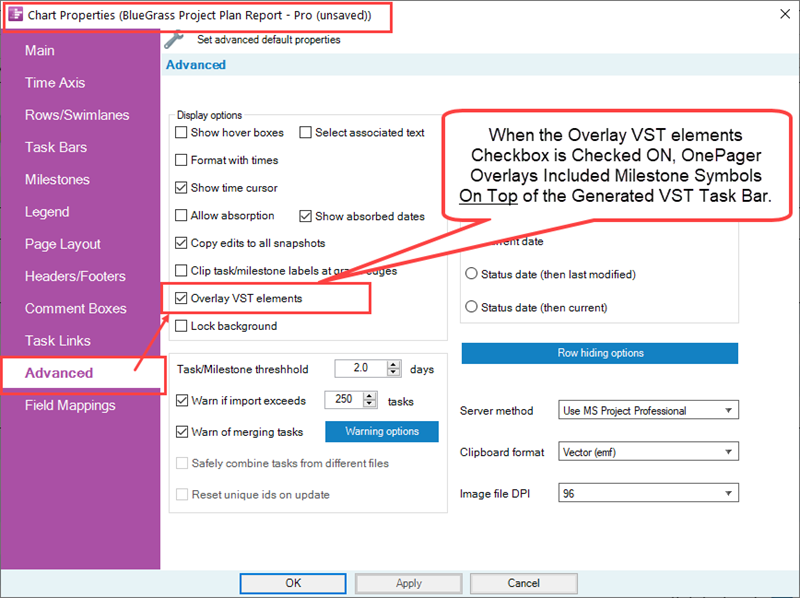
The same checkbox is also available in the Template Properties form’s Advanced tab in the same control group to set the feature on for all charts and snapshots created under that Template.
It is strongly recommended that you hide the task bar name labels for the task bars or milestone symbols you select to become members of the VST. This is because without hiding the task bar name labels they will appear overlaid onto the VST along with the task bar and/or milestone symbol selected to participate. This consequence may cause task bar name label collisions on the VST task bar that may be unwanted.
As another example, using the BlueGrass... chart shown below where the seven (7) original task bars are now represented as milestone symbols at the START DATE and again hide the task bar name labels to better illustrate the result:
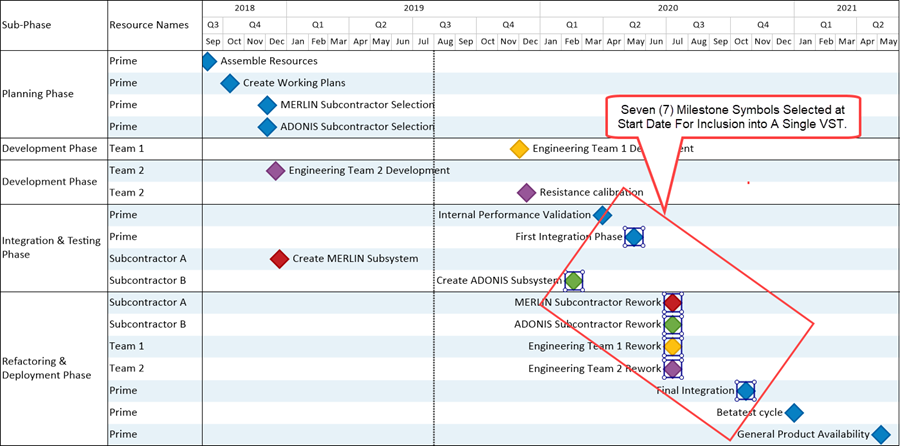
With the Overlay VST elements checkbox checked ON, a VST is created as described in the previous section. The resulting VST looks like this:
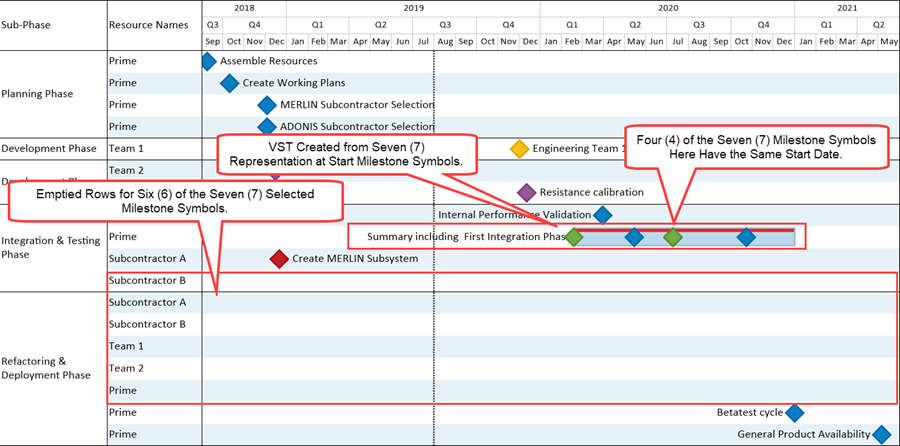
If you want to move the VST to another row or swimlane, there are two (2) recommended approaches on how to do this efficiently.
First Recommendation
If the VST and milestone symbol configuration is the only thing in the row or swimlane, it is recommended that the move be done by making the move as a row or swimlane move versus trying to select the VST as a task bar and move the task bar individually. The reason is that the overlays of milestone symbols are separate graphics from the VST task bar and do not move with the VST task bar.
Second Recommendation
If the VST and milestone symbols configuration occupy a row or swimlane with other task bars/milestone symbols, we recommend that you lasso the entire configuration which selects all task bars/milestone symbols and with the selection lasso active, make the move up or down for the selected task bars/milestone symbols.
Caution
The Overlay VST elements checkbox is intended to be used ONLY with milestone symbols. Accordingly, if the Overlay VST elements checkbox is checked ON and task bars are being made into a VST the results may not be appropriate for your needs. Further, making Virtual Summary Tasks with the Overlay VST elements checkbox checked ON also brings the task bars/milestone symbol's name labels into the VST which may further complicate the look of the resulting VST.
Task Links and Virtual Summary Tasks (VST)
If you are creating or editing Virtual Summary Tasks (VST) that have either Data-Driven or manual Task Links, it is important to be aware of how those Task Links appear after the creation or editing processes are complete. Any Task Links associated with the VST task bar/milestone symbols are hidden in the resulting VST representation.
For more information on the subject of Task Links and Virtual Summary Tasks, please see this section in the article at: Manual Editing of Task Links for OnePager Pro - Task Links and Virtual Summary Tasks (VST)
Related Links
Manual Editing of Task Links for OnePager Pro)
Template Only Features-OnePager Pro
Template Only Features-OnePager Express
(18.0.1-70)